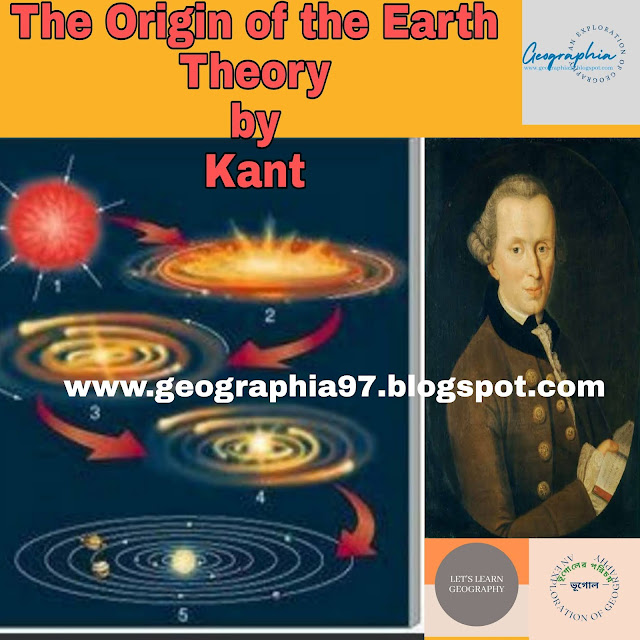The Gaseous Hypothesis Theory By Kant
PREPARED BY
SAYANTANI SINGH (Msc., GEOGRAPHY,B.ED)
NEBULA: It is a primordial mass of cloud of gas and
dust.
Angular velocity: the velocity is the angle moved by a rotating body
per unit time at a point on the axis of rotation.
Centrifugal force: a force which pulls the mass away from the centre
of the earth.
Centripetal force: a force which pulls the mass towards centre of the
earth.
Immanuel Kant, the German philosopher, presented his Book entitled ‘The General Natural History and Theory of the Heaven or the Essay on the Working and Mechanical Origin of the Entire Universe on the Basis of Newtonian Laws’ in 1755. Kant claimed that his ‘gaseous hypothesis’ of the origin of the earth was based on the sound principles of Newton’s laws of gravitation and rotatory motion.
Postulation/Assumption
- Supernaturally created primordial
hard matter was scattered in the universe.
- Nebula and the other matters were
comprised of very cold, solid, and motionless particles.
- Particles began to collide against
each other under their gravitational attractions.
- This mutual attraction and collision between the particles generated random motion in the primordial matter. Collision of the particles also generated friction which generated heat, with the result the temperature of the primordial matter started rising.
EXPLAINATION OF THEORY
According to Kant –
- The gravitational attraction and
collision between the particles generated random motion in the primordial
matter.
- Particles will collide against each
other’s and generate friction which generates heat.
- As a result the temperature of the
primordial matter started increasing.
- With the increase in temperature,
the motion as well as the rate of collision among the particles also
increased.
- The rise in temperature also
changed the state of primordial matter from solid to gaseous particles.
- Thus,
the original cold and motionless cloud of matter became a vast hot nebula
and started rotating around its axis.
- With continuous increases in
temperature and rate of motion, the nebula started expanding in size.
- The heat increased, the size of
nebula increased and as the size of nebula increased, the angular velocity
increased.
- Due to a continuous increase in the
size of the nebula and the angular
speed became so fast that the centrifugal force exceeded the attritional
or centripetal force
- The nebula started spinning so
rapidly that an irregular ring was separated from the middle part of the
nebula and was thrown off due to centrifugal force.
- By the repetition of the same
process a system of concentric rings was separated from the nebula.
- The central mass of the nebula
remained as the sun.
Evaluation
- Did not mention the origin of the
primordial matter: According to Kant there was a primordial matter in
the universe, but, he did not explain the source of the origin of the
primordial matter.
- Kant did not explain the source of
energy to cause the random motion of the particles of the primordial
matter which were cold and motionless in the initial stage.
- The collision among the particles
of the primordial matter can never generate rotatory motion in it. It is
an erroneous statement of mechanism.
CONCLUSION:
it was the first scientific attempt for the explanation of the origin of the
earth. Kant’s hypothesis plays a vital role in the assumption of the
Nebular hypothesis by Laplace.
If you want to join my telegram group
Ncert short note chapter 1 click here
Ncert solution chapter 1 click here
Ncert short note chapter 2 click here
Ncert Solution chapter 2 click here
NCERT short note chapter 3 click here
NCERT SOLUTION CHAPTER 3 CLICK HERE
NCERT CHAPTER 4 CLICK HERE
NCERT CHAPTER 4 SOLUTION CLICK HERE
NCERT CLASS 6 CHAPTER 5 SHORT NOTE CLICK HERE
ICSE class -ix click here
ICSE class -x click here
উচ্চমাধ্যমিক ভূগোল – দ্বাদশ শ্রেণী টেস্ট পেপার (প্রশ্ন ও উত্তর) | click here










0 Comments